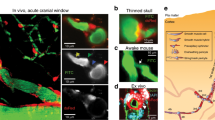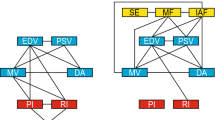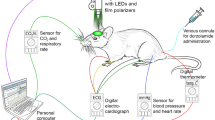Abstract
ANY marked increase in the metabolic demands of the cerebral cortex, caused, for example, by increased activity, is accompanied by an intensification of cortical circulation1–3. This occurs independently of the systemic arterial pressure which remains unaltered. The width of the major arteries of the brain (internal carotids and vertebrals) does not change in conditions of increased cortical activity4 and even diminishes after a temporary deficiency of blood supply to the brain5,6. These arteries therefore do not, in the above conditions, contribute to an increase in cerebral circulation. It was therefore necessary to learn more about the functional behaviour of both pial and cortical arteries, as the possible vascular mechanisms responsible for increase of blood supply to the cerebral cortex when its metabolic demands are heightened.
This is a preview of subscription content, access via your institution
Access options
Subscribe to this journal
Receive 51 print issues and online access
$199.00 per year
only $3.90 per issue
Buy this article
- Purchase on Springer Link
- Instant access to full article PDF
Prices may be subject to local taxes which are calculated during checkout
Similar content being viewed by others
References
Ingvar, D. H. in Reticular Formation of the Brain, 381 (Little, Brown and Company, Boston, Massachusetts, 1958).
Kanzow, E., and Krause, D., Pflügers Arch. ges. Physiol., 274, 447 (1962).
Ingvar, D. H., Mchedlishvili, G. I., and Eckberg, R., Proc. Acad. Sci. U.S.S.R. (in the press).
Mchedlishvili, G. I., Trans. Inst. of Physiol., Georgian Acad. Sci., 13, 147 (Tbilisi, 1963).
Mchedlishvili, G. I., Bull. exp. Biol. and Med. (U.S.S.R.), 49, No. 6, 21 (1960).
Rothenberg, S. F., and Corday, E. in Cerebral Anoxia and Electroencephalogram, 130 (edit. by Meyer, J. S., and Gastaut, H.) (Springfield, 1961).
Luse, S. A. in Ultrastructure and Metabolism of the Nervous System, 1 (The Williams and Wilkins Co., Baltimore, 1962).
Pease, D. C., and Schultz, R. L. in Blood Vessels and Lymphatics, 233 (edit. by Abramson, D. I.) (Academic Press, New York and London, 1962).
Mchedlishvili, G. I., and Baramidze, D. G., Proc. Acad. Sci., U.S.S.R., 163, 529 (1965).
Fåhraeus, R., and Lindquist, T., Amer. J. Physiol., 96, 562 (1931).
Isenberg, I., Bull. Math. Biophys., 15, 139 (1953).
Mchedlishvili, G. I., Kuparadze, M. R., Baramidze, D. G., and Nikolaishvili, L. S. in Epilepsy, 1, 192 (“Medicina” Publishing House, Moscow, 1964).
Moskalenko, Yu. E., Cooper, R., Crow, H. J., and Gray, W., Nature, 202, 159 (1964).
Author information
Authors and Affiliations
Rights and permissions
About this article
Cite this article
MCHEDLISHVILI, G., BARAMIDZE, D. & NIKOLAISHVILI, L. Functional Behaviour of Pial and Cortical Arteries in Conditions of Increased Metabolic Demand from the Cerebral Cortex. Nature 213, 506–507 (1967). https://doi.org/10.1038/213506a0
Issue Date:
DOI: https://doi.org/10.1038/213506a0
This article is cited by
-
Pial Arteries Respond Earlier than Penetrating Arterioles to Neural Activation in the Somatosensory Cortex in Awake Mice Exposed to Chronic Hypoxia: An Additional Mechanism to Proximal Integration Signaling?
Journal of Cerebral Blood Flow & Metabolism (2014)
-
The Modular Organization of the Pial Arterial System in Phylogeny
Journal of Cerebral Blood Flow & Metabolism (1984)
-
Arrangement and responses of smooth-muscle fibers in arterial walls in the cerebral cortex
Bulletin of Experimental Biology and Medicine (1970)
-
Evidence of a cholinergic nervous mechanism mediating the autoregulatory dilatation of the cerebral blood vessels
Pfl�gers Archiv European Journal of Physiology (1970)
-
�ber die Lokalisation des Str�mungswidertandes im Hirnkreislauf
Pfl�gers Archiv European Journal of Physiology (1969)
Comments
By submitting a comment you agree to abide by our Terms and Community Guidelines. If you find something abusive or that does not comply with our terms or guidelines please flag it as inappropriate.



